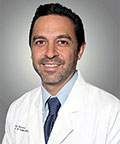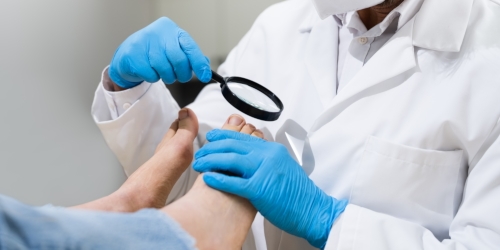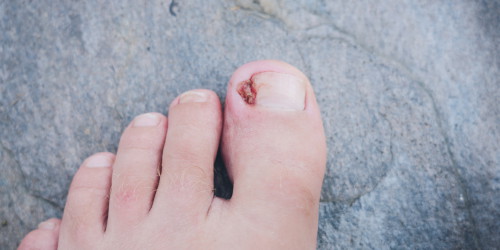- Home
- Foot & Ankle Conditions
- Toenails Conditions
- Ingrown Toenail
ingrown Toenail: causes, symptoms and treatment
- Published 8/31/2018
- Last Reviewed 3/26/2024

What's an Ingrown Toenail?
An ingrown toenail (also called onychocryptosis) is a common foot problem that involves the nail curving down into the surrounding skin as it grows.
Once the edge of the nail breaks through the skin, it can produce inflammation and discomfort. Left untreated, an ingrown toenail may lead to infection, bone disorder, or a recurring problem.
- What are the common causes of an ingrown toenail?
- What are conservative treatment options for an ingrown toenail?
- What are ingrown toenail surgical treatment options?
- What is ingrown toenail surgery recovery like?
- The connection between ingrown toenails and paronychia
- University Foot and Ankle Institute, your best treatment choice for all toenail conditions
- Frequently Asked Questions about Ingrown Toenails and Toenail Removal
- How long does ingrown toenail surgery take?
- Is toenail removal generally covered by insurance?
- Can I wear shoes after ingrown toenail removal surgery?
-
ABFAS® Board Certified in Foot Surgery and Reconstructive Rearfoot and Ankle Surgery. and Director of University Foot and Ankle Institute
Dr. Bob Baravarian DPM, FACFAS is a Board-Certified Podiatric Foot and Ankle Specialist. He is an assistant clinical professor at the UCLA School of Medicine and serves as Director of University Foot and Ankle Institute.
Dr. Baravarian has been involved in athletics his entire life and played competitive tennis in high school and college. He has an interest in sports medicine, arthritis therapy, and trauma/reconstructive surgery of the foot and ankle. He is also fluent in five languages (English, French, Spanish, Farsi, and Hebrew),
-
ABFAS® Board Certified in Foot Surgery and Reconstructive Rearfoot and Ankle Surgery. and Director of University Foot and Ankle Institute
Dr. Bob Baravarian DPM, FACFAS is a Board-Certified Podiatric Foot and Ankle Specialist. He is an assistant clinical professor at the UCLA School of Medicine and serves as Director of University Foot and Ankle Institute.
Dr. Baravarian has been involved in athletics his entire life and played competitive tennis in high school and college. He has an interest in sports medicine, arthritis therapy, and trauma/reconstructive surgery of the foot and ankle. He is also fluent in five languages (English, French, Spanish, Farsi, and Hebrew),
Learn More from our Ingrown Toenail Blog Articles
 Dr Bavarian was kind and helpful with my foot problem. I'm from Phoenix and came over to LA because I heard he could help. He ...Mary W.
Dr Bavarian was kind and helpful with my foot problem. I'm from Phoenix and came over to LA because I heard he could help. He ...Mary W. I liked it.Liisa L.
I liked it.Liisa L. I depend on the doctors at UFAI to provide cutting edge treatments. Twice, I have traveled from Tucson, Arizona to get the car...Jean S.
I depend on the doctors at UFAI to provide cutting edge treatments. Twice, I have traveled from Tucson, Arizona to get the car...Jean S. They helped me in an emergency situation. Will go in for consultation with a Dr H????
They helped me in an emergency situation. Will go in for consultation with a Dr H????
Re foot durgeryYvonne S. It went very smoothly.Maria S.
It went very smoothly.Maria S. My experience at the clinic was wonderful. Everybody was super nice and basically on time. Love Dr. Bavarian and also love the ...Lynn B.
My experience at the clinic was wonderful. Everybody was super nice and basically on time. Love Dr. Bavarian and also love the ...Lynn B. I fill I got the best service there is thank youJames G.
I fill I got the best service there is thank youJames G. Wonderful organization. Incredibly helpful and accommodating staff. And brilliant, warm, caring physician in Dr. Franson. C...Jg J.
Wonderful organization. Incredibly helpful and accommodating staff. And brilliant, warm, caring physician in Dr. Franson. C...Jg J. My experience with your practice far exceeded any of my expectations! The staff was always friendly, positive and informative. ...Christy M.
My experience with your practice far exceeded any of my expectations! The staff was always friendly, positive and informative. ...Christy M. Love Dr. Johnson.Emily C.
Love Dr. Johnson.Emily C. I am a new patient and felt very comfortable from the moment I arrived to the end of my visit/appointment.Timothy L.
I am a new patient and felt very comfortable from the moment I arrived to the end of my visit/appointment.Timothy L. Dr. Briskin and his team were ultra professional in every way, and I am very happy with my result. I was out of my boot cast a ...Holly C.
Dr. Briskin and his team were ultra professional in every way, and I am very happy with my result. I was out of my boot cast a ...Holly C.




